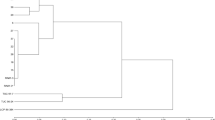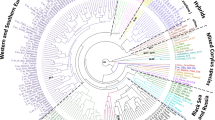Abstract
Solitary revertants which have been observed on single mutant tree individuals have up to now been believed to be grow-through cells belonging to the rootstock on which they are commonly grafted. In this study three different phenotypically visible mutants revealing revertant shoots on the same tree were chosen for genetic analysis. The mutant Quercus robur L. ‘argenteomarginata’ was grafted on a normal rootstock, an individual of Carpinus betulus L. var. quercifolia Desf. as well as an individual of Picea glauca (Moench) Voss. ‘conica’ are supposed to have grown from seeds. By means of a highly specific M13 PCR fingerprinting technique the mutant and revertant tissues were analysed in comparison to different individuals of each of the species. With the grafted mutant, cambium tissue of the rootstock was also investigated. Whereas conspecific individuals could be clearly distinguished from each other, mutant and revertant tissues revealed the same banding patterns for each of the three trees. In case of the grafted mutant, the fingerprint obtained from cambium tissue of the rootstock was clearly different from the pattern of mutant and revertant tissue. Results demonstrate the potential of the tool for genetic differentiation between individuals of three tree species hence in the case of the grafted mutant, the hypothesis that the observed reversion is caused by a grow-through of the rootstock is rejected. Furthermore, identical fingerprints of mutant and revertant tissue support identical genetic background of the tissues excluding the gene(s) responsible of the mutation. Possible causes of mutations and reversions regarding the three mutant trees are discussed.
Similar content being viewed by others
Author information
Authors and Affiliations
Additional information
Received: 15 September 1997 / Accepted: 24 November 1997
Rights and permissions
About this article
Cite this article
Fladung, M., Ziegenhagen, B. M13 DNA fingerprinting can be used in studies on phenotypic reversions of forest tree mutants. Trees 12, 310–314 (1998). https://doi.org/10.1007/s004680050156
Issue Date:
DOI: https://doi.org/10.1007/s004680050156




